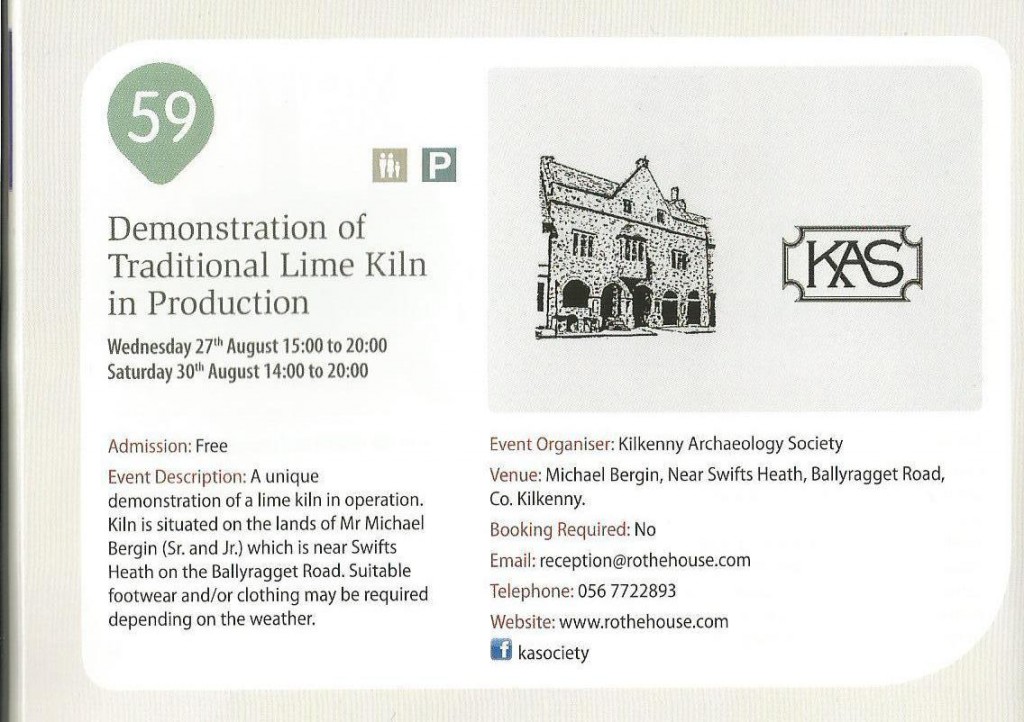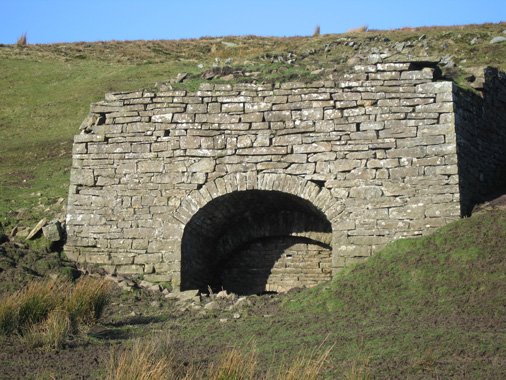
Filed Under: News


ON WEDNESDAY THE 20th OF AUGUST A LIME KILIN on X BERGINS FARM IN CONAHY WILL BE LIT AS A DEMONSTRATION OF HOW THEY WERE USES.
THIS WILL TAKE PLACE FROM 4 TO 8 O CLOCK THIS IS A RARE OPPERTUINIY TO SEE ONE OF THESE IN ACTION
ALL ARE WELCOME
What are Lime Kilns?
Lime kilns are structures in which limestone was heated to a high temperature to produce quicklime. Quicklime was used as a raw material for a number of uses locally.
Lime Production:
Limestone (calcium carbonate) is a sedimentary rock produced largely in the marine environment from the shells of sea creatures over geologic time periods.When heated (or “burnt”) the limestone is converted to quicklime (calcium oxide) and a gas (carbon dioxide). Quicklime will react with water to give “slaked lime” (calcium hydroxide).
“Lime” – unfortunately, limestone, quicklime and slaked lime can all be referred to as “lime”, and so there can sometimes be confusion as to what material is being discussed. The three materials are unique chemical compounds and each has different properties that may be put to good use.
History of Lime Kilns:
The burning of limestone, to produce quicklime is known to have been carried out in antiquity. The oldest recorded lime kiln has been dated to about 2450 BC in Iraq. In Ireland lime burning is known to have taken place in the pre-Christian era. Lime use for soil improvement took place in the 12th century and became widespread in the 18th century. In the civil survey of 1654/56 it was said that “there is no part of Ireland where so much lime is burned as in the south side of the Barony of Muskerry [in which Ballincollig is included]. From the head of the vale of Castlemore to below Kilcrea, on all the adjacent hills there are a great number of lime kilns”.The number of lime kilns increased dramatically in the 18th and early 19th century and it was estimated that there were about 23,000 lime kilns in the County of Cork. With the coming of the railways and the growth of large scale industrial processes in the 1850s the use of small lime kilns became progressively uneconomic. However, lime kilns continued to be constructed in the Cork area into the 20th century as late as 1948. The majority of the small lime kilns, which were recorded in the 1850s, have now been destroyed. Lime is still “burnt” in Ireland, but in very large continuous rotary kilns that are used to produce cement whose principal component is quicklime. There are currently about 10 industrial rotary cement kilns in Ireland using about 3.5 million tonnes of limestone per year. Burnt lime for land use has been replaced by finely ground limestone. This has the same agricultural effects as the burnt lime and is much cheaper to produce.
In 1999 an existing traditional limekiln in north Cork was put back into production as a re-enactment of the old lime burning process.

Photo 2 – Horse and Cart bringing limestone from a quarry to the lime kiln.

Photo 3 – Removing Lime from the Limekiln

Outline Drawing of a Lime Kiln
General Description of Lime Kilns and Operation of Lime Kilns:
The most common type of lime kiln consisted of an egg-shaped bricked chamber with an opening at the bottom of the chamber for air admission, fire setting and quicklime removal. The kilns were 4 – 8 metres in width, of roughly square section and 5 – 8 metres in height. The lime burning was carried out as a single firing, or batch basis, or on a continuous burning basis (continuous draw kilns). Because the lime kiln was filled from the top of the kiln and could be unloaded from the top, access to the top of the kiln was necessary. The kiln was constructed on either a rock face, or earthen bank, to permit this. A ramp was then constructed to permit access to the top of the kiln.
A metal grid, or arch of limestone, was present at the bottom of the lime kiln to act as a temporary roof on which to support limestone or a series of layers of fuel and limestone. The fuel was lit at the bottom of the kiln and the burning process allowed to proceed. A minimum temperature of about 900°C (the limestone reaching a bright red heat) is required to convert the limestone to quicklime. In the case of the batch process, the burning took around 4 days. Continuous burning lime kilns were replenished with limestone and fuel from the top of the kiln for as long as required.
The quicklime “stones” could be either removed from the lime kiln from the bottom of the kiln, or, taken out through the top of the kiln when the kiln had cooled.
Limestone naturally contains other minerals that can affect its fitness for use, for example, iron or manganese, and silt. Limestone of particular purity was selected where required. The presence of the ash from the fuel may also introduce undesirable impurities and affect its use. In this case, the batch process was used and the fuel confined to the bottom section of the kiln.
Lime Kiln Fuels:
Many types of fuel were used in lime kilns. The choice generally depending on local availability rather than any unique material. The fuels used were,
Lime Uses:
The main period of activity for lime kilns was between 1750 and 1850. Land use was the main outlet for burnt lime. The modern advertising slogan for agricultural lime use is “Give Life to the Land”. This was balanced by the old saying “Lime enriches the father but impoverishes the son”. This refers to the transitory nature of the land improvement after a liming and the requirement for further lime additions to keep up the crop productivity.

Photo 4 – Classes lime kiln